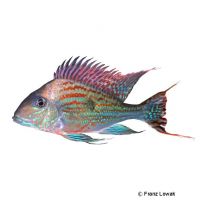Megasema Geophagus (Geophagus megasema)
| Megasema Geophagus Geophagus megasema | |
|---|---|
| Name | Megasema Geophagus |
| Name Lat. | Geophagus megasema |
| Family | Cichlids |
| Family lat. | Cichlidae |
| Order | Cichlids |
| Order lat. | Cichliformes |
| Origin | South America |
| Habitat | Rivers |
| Diet | Omnivore |
| pH | 5.5-7.5 |
| Behavior | Peaceful |
| Keeping | Pair, group |
| Care Level | Difficult |
| Reproduction | Mouthbrooder |
| Breeding | Moderately difficult |
| Life Span | 8-10 years |
| Protection | No |
| Metric Units | |
| Size | 15-18 cm |
| Temperature | 22-30 °C |
| Hardness | 1-15 °dH |
| Aquarium | 300 l |
| US Units | |
| Size | 5.9"-7.1" |
| Temperature | 72-86 °F |
| Hardness | 18-267 ppm |
| Aquarium | 80 gal |
Distribution and habitat
The distribution area of the Megasema geophagus is the river system of the upper Rio Madeira in Bolivia and Brazil. They live there in the sloping shore zones over sand, fine gravel and mud between rocks, foliage and dead wood.
Maintenance
The aquarium should have a robust border planting, with some round river stones and roots as hiding places, and plenty of free sandy areas suitable for burrowing. A soft, deep substrate covered with some foliage (e.g. sea almond tree, oak), subdued light (floating plants) and soft, slightly acidic water with a weak current is ideal.
No ammonia, ammonium and nitrite should be detectable in the water, and the nitrate value should not exceed 100 mg/l. To ensure the water quality and oxygen content, a filter and heater adapted to the aquarium size is required, as well as lighting for the species-appropriate day-night rhythm of the animals.
Diet
The food supply consists of live or frozen Tubifex, Artemia, mosquito larvae, shrimps etc. supplemented with a high quality sinking dry food for cichlids (granules, pellets, tabs). In addition, they need regular vegetable food, such as algae leaves or dry food with high vegetable content (spirulina). It is recommended to feed small portions several times a day
Only feed as much as will be eaten within a few minutes. Regular and varied feeding promotes health and increases resistance
Behaviour and compatibility
They should be kept in pairs or better in a group of 5-8 animals. In too small groups the intra-species aggressiveness increases. They are only territorial during the spawning season. Keeping a larger group is only recommended in a larger and richly structured tank. They are compatible with other fish and can be socialized well with calmer, warmth-demanding fish
Basically, only compatible fish species with similar demands on water conditions and water temperature may be socialized.
Sex dimorphism
The sexes are difficult to distinguish. The males usually grow larger and appear more bulky. With some experience, the sexes can be distinguished by their genital papilla, which is pointed in the male and round in the female.
Reproduction and breeding
They are larvophilic mouth brooders. The eggs are laid by the female on a flat, well-cleaned rock or similar and fertilized by the male. The larvae hatch after about 2 days and are immediately taken up by the female, sometimes both parents, in their spacious gullet (pharynx) for mouthbrooding. After 7-14 days, the fry are released from the mouth. If danger threatens, the fry flee back into the mouth of the parents. They are guarded by both parents for a few more days before brood care ends
Fry must be fed several times a day with special rearing food (Artemia nauplii). In community tanks breeding is hardly possible, because the fry are easy prey.
Important
They rummage through the substrate in search of food. According to this species-typical behavior, they are also called soil eaters. Plants are not eaten, but should be placed in pots and secured with stones against digging out. The foliage (sea almond tree, oak etc.) enriches the water with humic substances and lowers the pH value in a natural way.
The well-being of the fish should be checked regularly. Temperature should be checked daily, pH, hardness and nitrate levels should be checked at least every 14 days. Regular partial water changes are recommended, even if the contaminant level has not yet reached the upper limit. Sudden changes in water quality should be avoided. Newly introduced fish must be accustomed slowly to the water in the aquarium.
Further literature can be found in your pet store.
References
Text: petdata; Image: Franz Lowak
Source: BMELV (1998): Tierschutzgutachten - Haltung von Zierfischen (Süßwasser); RIEHL & BAENSCH (2006): Aquarien Atlas Bd. 1, Mergus Verlag; ENGELMANN (2005): Zootierhaltung - Tiere in menschlicher Obhut: Fische, Verlag Harri Deutsch
- Gemäß § 21 Abs. 5 Tierschutzgesetz idgF
